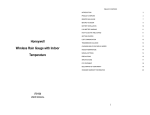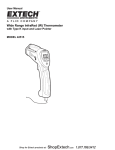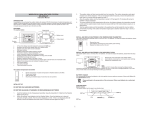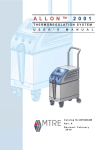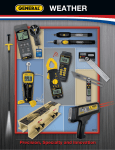Download RGR150 Wireless Rain Gauge with Thermometer and Clock
Transcript
RGR150 manual-FINAL-091908:Layout 1 9/19/08 8:59 AM Page 1 Test Equipment Depot - 800.517.8431 - 99 Washington Street Melrose, MA 02176 - TestEquipmentDepot.com RGR150 USER’S MANUAL Wireless Rain Gauge with Thermometer and Clock INTRODUCTION Thank you for selecting this Wireless Rain Gauge. This device monitors and displays rainfall data along with the indoor/outdoor temperature from up to three remote locations. Please read and follow the manual carefully. RGR150 manual-FINAL-091908:Layout 1 IN THIS PACKAGE YOU WILL FIND: CH PM • One main unit (receiver) • One remote rain gauge (transmitter) 4 3 3 M H z W I R E L E S S 3 THERMO – SENSOR • One remote temperature sensor (transmitter) 9/19/08 8:59 AM PRODUCT OVERVIEW MAIN UNIT FEATURES • Wireless transmission of the rainfall data from the remote rain gauge to the main unit up to 100 feet (30 meters) away • Wireless transmission of the temperature from the remote temperature sensor to the main unit up to 100 feet (30 meters) away • Rainfall may be displayed in inches or mm • Programmable Rain Alarm • 7 days of rain collection history • Built-in rain gauge installation level • Indoor and remote temperature display • MIN/MAX memory for indoor/outdoor temperature • Hourly, daily and weekly rainfall history • Monitors temperature in up to 3 remote locations • Quartz clock with calendar • Programmable Time Zones • Day of the week in English, German, French, Spanish or Italian • Dual crescendo alarm with snooze • Programmable Ice Warning Alarm • Wall mount or desktop option • Low battery indicator • LED backlight FRONT VIEW MAIN RECEIVER UNIT (RAIN MODE CONTROL PANEL) A. Weather and time information A three-line LCD display Please keep this manual handy as you use your new item. It contains practical step-bystep instructions, as well as technical specifications and precautions you should know. Page 2 B. ALARM button • Toggles between the rainfall modes – a current rainfall data and a rain alarm programming mode • Activates the high rainfall alarm setting mode RGR150 manual-FINAL-091908:Layout 1 9/19/08 8:59 AM Page 3 FRONT VIEW (MAIN RECEIVER UNIT) (RAIN MODE CONTROL PANEL) REAR VIEW (MAIN RECEIVER UNIT) (TIME AND TEMPERATURE CONTROLS PANEL) C. MODE button • Toggles between the rainfall modes – for the past hour, 24 hours, and for the past 7 days H. MODE button • Toggles between four clock modes – time with seconds, time with the day of the week, Time Zone programming and calendar D. UP ▲ button • Toggles between the rainfall modes – for the past hour, 24 hours, and for the past 7 days • Increases all function parameters; press and hold for rapid increase • Enables or disables rain alarm E. DOWN ▼ button • Toggles between the rainfall modes – for past hour, for the past 24 hours, and for the past 7 days • Decreases all function parameters; press and hold for rapid decrease • Enables or disables high rain alarm • Enforces the remote rain gauge signal search F. MEMORY button • Toggles between the rainfall memory modes – for the past hour, 24 hours, and for the past 7 days • Clears the memory I. UP ▲ button • Increases all time and temperature function parameters • Enables the time alarms J . DOWN ▼ button • Decreases all time and temperature function parameters • Disables the time alarms • Enforces the remote temperature sensor signal search K. ALARM button • Toggles between the alarm modes – weekday alarm ( W ), single alarm ( S) and ice warning alarm (Pre-AL) L. MEMORY button • Toggles between current, minimum and maximum readings of the indoor and remote temperatures • Clears the memory RGR150 manual-FINAL-091908:Layout 1 M. CHANNEL button • Recalls a different channel of the remote temperature • Enables remote temperature channels auto scanning feature N. SNOOZE/LIGHT button • Enables backlight for 5 seconds • Stops any alarm temporarily 9/19/08 8:59 AM A. Rain gauge bucket Holds all rain gauge components B. Knob Secures the top on the rain gauge bucket C. Rain gauge bucket feet Allow securing the rain gauge on its place REMOTE RAIN GAUGE O. BATTERY COMPARTMENT • Accommodates 2 “AA” batteries P . WALL-MOUNT RECESSED HOLE • Keeps the main unit on the wall Q. REMOVABLE TABLE STAND • Keeps main unit in upright position on a flat surface REMOTE RAIN GAUGE FEATURES • Precipitation measurement • Remote rainfall data transmission to the main unit via 433 MHz signal • 100 feet (30 meters) transmission range without interference • Built-in installation level • Mounting hardware • Non-corrosive protective screen D. Funnel-shaped top with battery compartment Contains battery compartment and rainfall counting electronics E. Battery compartment Holds 2 “AA” batteries F. Screws Secure battery compartment cover G. Built-in leveler Allows leveling rain gauge on the surface H. Bucket see-saw mechanism Collects the rainfall in one of its containers and self-empties once full I. Protective screen Protects the rain gauge funnel from debris REMOTE TEMPERATURE SENSOR FEATURES (see diagram next page) • Remote temperature transmission to the main unit via 433 MHz signal • 100 feet (30 meters) transmission range without interference • LCD display of measured temperature • Three transmission (3) channels selection • Selection of the temperature display in Celsius or Fahrenheit • Case can be wall mounted using built-in hanger Page 4 RGR150 manual-FINAL-091908:Layout 1 9/19/08 8:59 AM Page 5 A. LED INDICATOR • Flashes once when the remote temperature sensor transmits a reading to the main unit. • Flashes twice when battery power is low. B. BATTERY COMPARTMENT • Holds 2 “AA” batteries C. RESET • Resets all readings D. CHANNEL SWITCH • Selects the desired channel E. WALL-MOUNT RECESSED OPENING • Keeps the remote temperature sensor on the wall F. ºF/ºC SELECTOR • Selects the temperature display in Fahrenheit or Celsius BEFORE YOU BEGIN • We recommend using alkaline batteries for the remote rain gauge, temperature sensor and main unit when temperatures are above 32ºF (0ºC). We recommend using lithium batteries for the temperature sensor when temperatures are below 32ºF (0ºC). • Avoid using rechargeable batteries. (Rechargeable batteries cannot maintain correct power requirements). • ALWAYS install batteries in the remote rain gauge and the remote temperature sensor before the main unit. • Insert batteries before first use, matching the polarity in the battery compartment • Press RESET in the remote temperature sensor after each battery change with a paper clip or similar tool. • Remove protective plastic screen from LCD display (If any) • During an initial setup, place the main unit close to the remote rain gauge and remote temperature sensor • Important: Only after reception is established (the remote rainfall data and temperature will appear on the main unit’s display), you may position and mount the remote sensors (the rain gauge and the temperature sensor) and the main unit within the effective transmission range of 100 feet (30 meters). • The remote rain gauge must be placed outdoors on the open area, away from the walls, fences and trees and level. • It is important that excess precipitation can freely flow from the remote rain gauge. • The remote temperature sensor can be placed indoors or outdoors, depending on the area where the temperature is intended to be measured. If you intend measuring outdoor temperature, place the remote temperature sensor outdoors. • The main unit must be placed indoors. NOTE: 1. Avoid pressing any buttons on the main unit before the remote rainfall and temperature data are displayed. 2. The effective operating range may be influenced by the surrounding building materials and how the receiver (main unit) and transmitters (remote rain gauge and temperature sensor) are positioned. 3. Place the remote rain gauge and temperature sensor so that it faces the main unit (receiver), minimizing obstructions such as doors, walls, and furniture. RGR150 manual-FINAL-091908:Layout 1 4. Though the remote temperature sensors are weather-resistant, they should be placed away from direct sunlight, rain or snow. The best suggested location for the remote temperature sensor for outdoors is under the eave on the north side of the building. NOTE: When the temperature falls below freezing, the batteries in the remote rain gauge and outdoor remote temperature sensor may have reduced voltage supply and a shorter effective range. We recommend using lithium batteries at temperatures of 32ºF (0ºC) and below. We also recommend covering the remote rain gauge tightly with a plastic during the winter time or move it indoors. RAIN GAUGE BATTERY INSTALLATION • Unlock the funnel-shaped top on the rain gauge by turning both knobs on the sides in an anti-clockwise direction. • Remove the funnel-shaped top lifting it off the rain gauge bucket. • Remove 7 small screws from the battery compartment cover using a small Phillips screwdriver. • Insert 2 “AA” size alkaline batteries (not included), matching the polarities as shown in the battery compartment. • Replace the battery compartment door and secure the screws. • Insert the funnel-shaped top into the rain gauge bucket and secure it into place by turning the knobs clockwise. PLACEMENT TIPS • Make sure that the remote rain gauge is level – check if the ball bearing inside the bucket is at the midpoint of the leveler. • Place the protective screen over the top to protect the rain gauge from the debris. • Mount the rain gauge using mounting hardware provided. • Make sure that the rain gauge is in open area where precipitation falls directly into the gauge’s bucket, ideally 2-3 feet above the ground. 9/19/08 8:59 AM Page 6 REMOTE TEMPERATURE SENSOR BATTERY INSTALLATION NOTE: Install the batteries; select the channel and temperature in °F or °C before mounting the remote temperature sensor. • Remove the screws from the battery compartment with a small Phillips screwdriver. • Set the channel. The switch is located in the battery compartment. Channel 1 is typically selected if only one remote sensor is being used. • Install 2 “AA” size alkaline batteries (not included) matching the polarities shown in the battery compartment. • Replace the battery compartment door and secure the screws. • Secure remote temperature sensor in the desired location. MAIN UNIT BATTERY INSTALLATION • Open the battery compartment door. • Install 2 batteries (UM-3 or “AA” size 1.5V) matching the polarity as shown in the battery compartment. • Replace the battery compartment door. LOW BATTERY WARNING A low-battery indicator [ ] will appear on the remote rainfall reading line and the indoor or remote temperature reading line of the main unit, warning that the corresponding batteries need replacement. HOW TO USE THE TABLE STAND The main unit has a removable table stand that supports it on a flat surface. Attach table stand to the bottom of the main unit in the slots provided. The main unit can also be mounted on the wall using the recessed screw hole. The table stand must be removed prior to mounting. The remote temperature sensor can be similarly mounted or placed on a flat surface. RGR150 manual-FINAL-091908:Layout 1 GETTING STARTED After the batteries are installed; the remote temperature sensor will transmit temperature readings at about 45 second intervals. The remote rain gauge will transmit rainfall data at about 183 second intervals. The main unit may take up to two minutes to receive the initial readings. Upon successful reception, the rainfall reading (0.00) will appear on the top line of the main unit’s display and the remote temperature will appear on the line below. The main unit will automatically update readings at 45-second intervals. If no signals received from the remote temperature sensor within two minutes, dashes [ ] will be displayed. Press and hold the front panel DOWN (▼) button on the main unit for two seconds or until Rain symbol will start flashing, to initiate a signal search for the remote rainfall. Press and hold the back panel DOWN (▼) button on the main unit for two seconds to initiate a signal search for the remote temperature. REMOTE AND INDOOR TEMPERATURES The remote temperature information is located on the middle line of the main unit’s display. The indoor temperature with the icon IN is located next to the remote temperature. The wave icon above the remote channel number indicates the reception status from the remote temperature sensor. There are three following types of the reception status that may be displayed: The Unit is in searching mode Temperature readings are securely registered No signals ˚F NOTE: If the indoor or remote temperature goes above or below operating range stated in specifications, the main unit’s display will show dashes “ ” 9/19/08 8:59 AM Page 7 AUTO-SCANNING Press and hold the CHANNEL button on the back on the main unit for 2 seconds – the icon “ ” will appear on the display’s middle line below the remote temperature channel number. All 3 remote temperatures will be displayed one-by-one automatically for 4 seconds each in the following sequence: Channel 1, Channel 2 and Channel 3. To exit from scanning mode, press and hold the CHANNEL button (on the back) for 2 seconds, and the icon “ ” will disappear, returning the main unit to the default display mode. CHECKING REMOTE RAINFALL DATA The remote rainfall information line is located on the top line of the main unit’s display. The rain icon “ ” is located to the left of the rainfall reading and indicates the reception status from the remote rain gauge. There are three following types of the reception status that may be displayed: The Unit is in searching mode Rainfall readings are securely registered No signals detected --- Press and hold the MODE button on the front panel to display the rainfall reading in inches or mm. RAINFALL HISTORY The rainfall history records will be automatically stored in the memory of the main unit. There are three historical records may be displayed – for the past hour, past day and past week. To display any of available rainfall history reading, use any button on the front panel except the ALARM button. The display sequence is: LAST HOUR, LAST 24 HOURS, and LAST 7 DAYS. To clear the memory, press and hold MEMORY button on the front panel for two seconds and all previously stored readings will be erased (all the historical records will display a default reading 0.00). RGR150 manual-FINAL-091908:Layout 1 MAXIMUM AND MINIMUM TEMPERATURE The maximum and minimum record of the indoor and remote temperatures will be automatically stored in the memory of the main unit. To display the minimum, maximum or the current reading press MEMORY button on the back panel. To clear the memory, press and hold MEMORY button on the back for two seconds and all previously stored readings will be erased. LOST COMMUNICATION • If the main unit display line for the remote temperature sensor reading goes blank, press and hold the back DOWN (▼) button for 2 seconds to begin a new signal search. If the signal still isn’t received, please make sure that: • The remote temperature sensor is in its proper location. • The distance between main unit and remote temperature sensor is not over 100 feet (30 meters). • The path between units is clear of obstacles. Shorten the distance if necessary. • Fresh batteries are installed correctly in both remote temperature sensor and main unit. • If there is no reception, please perform the following steps: • Bring the main unit and remote temperature sensor close together. • Remove four (4) small screws from the back of the remote temperature sensor with small Phillips screwdriver, and open the battery compartment. • Remove the batteries from the battery compartment and reinstall them in the same manner. Remote sensor LED indicator will flash showing transmission of the signal. • Remove the batteries from the main unit and reinstall them in the same manner. 9/19/08 8:59 AM Page 8 • The remote temperature appeared on the main unit’s display will show that transmission is being received successfully. • If the main unit display line for the remote rain gauge reading goes blank, press and hold the front DOWN (▼) button for 2 seconds to begin a new signal search. • If the signal still isn’t received, please make sure that: • The remote rain gauge is in its proper location. • The distance between main unit and remote rain gauge is not over 100 feet (30 meters). • The path between units is clear of obstacles. Shorten the distance if necessary. • Fresh batteries are installed correctly in both remote rain gauge and main unit. TRANSMISSION COLLISION Signals from the other household devices such as wireless doorbells, home security systems, and entry control, may interfere with this product or cause temporary reception interruption. This is normal and will not affect the general performance of the product. The transmission and reception of the remote readings will resume once the interference subsides. LANGUAGE, TEMPERATURE, CALENDAR AND CLOCK DISPLAY MODES Date is displayed in month-date or date-month format. Each press of the MODE button on the back panel will toggle the clock modes between the time with seconds, time with the day, time zone and a calendar. MANUAL SETTINGS REAR PANEL • Press and hold MODE button for 3 seconds: the 2 digit language letters will flash. • If you go into “zone” setting, press mode 2 times to get to day/month display, then hold “mode” button for 3 seconds to access “language” setting (1st mode). RGR150 manual-FINAL-091908:Layout 1 • Press UP (▲) or DOWN (▼) to change language. Languages available are DE, FR, IT, SP & EN. • After the language is set, press MODE button again to move to the next value • Continue setting temperature (in Celsius or Fahrenheit,) year, month, date, calendar format, (12 or 24 hour time format) hour and minutes. • After the last parameter is set, press MODE for the last time to return to the default mode (time of day with seconds). TIME ZONE • Select Time Zone setting mode by pressing MODE button until the word “ZONE” will appear to the left of time display • Press and hold MODE button until flashing“0:00” digits will appear prompting to set the desired time zone in 30 minutes intervals ALARMS HIGH RAIN ALARM The high rain alarm for the past 24 hours can be set and displayed at any time by pressing ALARM button on the front panel. To set the high rain alarm, • Press the ALARM button on the front panel until the “ALARM HI” will appear on the upper right corner of the rainfall information line. • Press and hold the ALARM button for 2 seconds or until the rainfall data digits will flash. • Enter the rainfall amount you want to set the rain alarm for using the front panel UP (▲) or DOWN (▼). • Press the ALARM button again to confirm and the high rain alarm will be set. NOTE: Press and hold the MODE button on the front panel to display the rainfall reading in inches or mm. TIME ALARMS The Wireless Rain Gauge has three available time alarms – Weekday alarm ( W ), Single alarm ( S ) and Ice Warning Alarm (Pre-Al). 9/19/08 8:59 AM Page 9 • If Weekday alarm is activated, it will sound at the set time and the alarm icon will flash Mondays through Fridays. • If Single day alarm is activated, it will sound at the set time and the alarm icon will flash only for this specific day and will not activate on subsequent days. • If Ice Warning Alarm is activated, in will sound at the set time and alarm icon will flash if the remote temperature for Channel One (1) will reach 35.6ºF (+2ºC) and below. NOTE: Ice Warning Alarm can be set only if one or both of the Weekday or Single alarm are programmed. SETTING THE WEEKDAY AND SINGLE DAY ALARMS • Press ALARM button once to enter into the alarms setting mode. The default alarm is a Weekday alarm. The abbreviation “OFF” with a letter “ W ” next to it will be displayed, if the alarm has not been set previously. • Press and hold the ALARM button for two seconds. The hour digit will flash. • Enter the hour using back panel UP (▲) or DOWN (▼). • Press the ALARM again. The minute digits will flash. • Enter the minutes using UP (▲) or DOWN (▼). • Press the ALARM button again to confirm and the weekday alarm time will be set. • Set Single day alarm if desired in the same manner. SETTING THE ICE WARNING ALARM If Weekday or Single day alarm is set, the Ice Warning Alarm can be programmed. • Press the back panel ALARM button once to enter into the Ice Warning Alarm setting mode. The abbreviation “OFF” with a “PRE-AL” next to it will be displayed. RGR150 manual-FINAL-091908:Layout 1 • Press and hold the back panel ALARM button for two seconds. The “30” number will flash, meaning that if selected, the alarm will sound 30 minutes earlier than the Weekday or Single alarm. • Enter the desired minutes from 15 to 90 minutes in 15 minutes intervals, using UP (▲) or DOWN (▼). • Press back panel ALARM button again to confirm and exit from the alarm setting mode. ACTIVATING THE ALARM • Press ALARM ON/OFF button to enter into the alarms mode. • Press DOWN (▼) to activate or UP (▲) to deactivate desired alarm. When alarms are activated, the corresponding icons will be displayed. SNOOZE When any alarm sounds, press the SNOOZE/LIGHT button to temporarily stop the alarm. After the SNOOZE/LIGHT is depressed, the alarm sound will resume in eight minutes. If the alarm is not disabled after that, it will sound for four more minutes and then will stop by itself. PRECAUTIONS This product is engineered to give you years of satisfactory service if handled carefully. Here are a few precautions: • Do not immerse the units in water. • Do not clean the units with abrasive or corrosive materials. They may scratch the plastic parts and corrode the electronic circuits. • Do not subject the product to excessive force, shock, dust, temperature, or humidity, which may result in malfunctions, shorter lifespan, damaged batteries, and damaged parts. • Do not tamper with the units internal components. Doing so will invalidate the warranty and may cause damage. These units contain no user-serviceable parts. 9/19/08 8:59 AM Page 10 • Use only fresh batteries. Do not mix new and old batteries. • Read the user’s manual thoroughly before operating the units. SPECIFICATIONS Main Unit TIME 12/24 hour display in hh: mm format Date format: month-day or day-month format Day of the week is selectable in five languages (English, Spanish, French, German, Italian) Time zone manual adjustment Dual two-minute crescendo alarms with 8 minutes snooze Programmable ice warning alarm (Channel 1) WEATHER Rainfall Proposed operating range: 0 to 1999.9mm/0 to 78.74 inch Rainfall resolution: 0.04 inch (1mm) Indoor Temperature Proposed operating range: 23.0º to 122.0ºF (-5.0º to +50.0ºC) Temperature resolution: 0.2ºF (0.1ºC) User-selectable (ºF or ºC) temperature display LED backlight Low battery indicator Wall Mount or Desktop option REMOTE RAIN GAUGE Remote Rainfall Data Proposed operating range: 23.0º to 122.0ºF (-5.0º to 50.0ºC) RF transmission frequency: 433 MHz RF transmission range: maximum 100 feet (30 meters) Rainfall transmission cycle: approximately 183 seconds RGR150 manual-FINAL-091908:Layout 1 REMOTE TEMPERATURE SENSOR Remote Temperature Proposed operating range with alkaline batteries: -4.0º to 158ºF (-20.0º to 70.0ºC) Proposed operating range with lithium batteries: -38.0º to 158ºF (-38.8º to 70.0ºC) Temperature resolution: 0.2ºF (0.1ºC) Low battery indicator RF transmission frequency: 433 MH Maximum number of remote sensors: 3 (1 included) RF transmission range: maximum 100 feet (30 meters) Temperature transmission cycle: approximately 45 seconds POWER Main unit: 2 “AA” batteries (not included) Remote sensor: 2 “AA” batteries (not included) Remote rain gauge: 2 “AA” batteries (not included) Dimensions Main unit: 2.75(L) x 5.43(H) x 1.02(D) inches Remote sensor: 2.37(L) x 4(H) x 1(D) inch Remote rain gauge: 6.49(L) x 6.89(H) x 4.72(D) inches FCC STATEMENT This device complies with Part 15 of the FCC Rules. Operation is subject to the following two conditions: (1) This device may not cause harmful interference, and (2) This device must accept any interference received, including interference that may cause undesired operation. Warning: Changes or modifications to this unit not expressly approved by the party responsible for compliance could void the user’s authority to operate the equipment. 9/19/08 8:59 AM Page 11 NOTE: This equipment has been tested and found to comply with the limits for a Class B digital device, pursuant to Part 15 of the FCC Rules. These limits are designed to provide reasonable protection against harmful interference in a residential installation. This equipment generates, uses and can radiate radio frequency energy and, if not installed and used in accordance with the instructions, may cause harmful interference to radio communications. However, there is no guarantee that interference will not occur in a particular installation. If this equipment does cause harmful interference to radio or television reception, which can be determined by turning the equipment off and on, the user is encouraged to try to correct the interference by one or more of the following measures: • Reorient or relocate the receiving antenna • Increase the separation between the equipment and receiver • Connect the equipment into an outlet on a circuit different from that to which the receiver is connected • Consult the dealer or an experienced radio/TV technician for help RGR150 manual-FINAL-091908:Layout 1 9/19/08 8:59 AM 99 Washington Street Melrose, MA 02176 Phone 781-665-1400 Toll Free 1-800-517-8431 Visit us at www.TestEquipmentDepot.com GENERAL TOOLS & INSTRUMENTS™ RGR150 User’s Manual Specifications subject to change without notice ©2008 GENERAL TOOLS & INSTRUMENTS™ NOTICE - WE ARE NOT RESPONSIBLE FOR TYPOGRAPHICAL ERRORS. MAN#RGR150 9/08 Page 12














